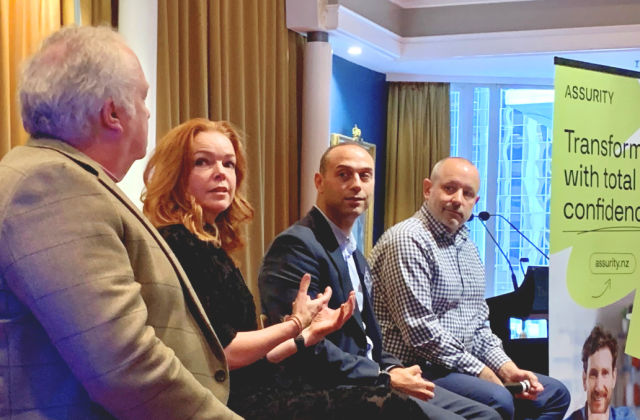Date: 09 May 2020
Last year, I went to a university grad show to look for new talent for the team, see how far things have progressed since I studied and, to be honest, drink the free wine. I also had a particular interest in this university because they had just started teaching a Design Thinking course and I knew a few lecturers there.
One of those lecturers gave me a guided tour with a running commentary on the best students and background into different projects. I was pretty impressed with the work on display. However, I had an odd encounter with one of the students on the stairs. He was describing the design process he went through in creating his app and talked about “Using Design Thinking, where you make up the customers you’re designing for”. Close… but no cigar.
I said it was great that he was interested in using Design Thinking methodology as a way to inform his design but, next time, he should try talking to actual customers. Without doing that, you’re still designing for ‘self’ and your app will be filled with your own assumptions. Well, that’s what I wished I’d said. The reality was more like me shouting “Try talking to real customers!” If that was the only takeaway he had after our conversation, I’d be happy. But it sowed a small seed of doubt and started me questioning what the Design Thinking syllabus covers.
Blindly following process?
During the evening, my all-access pass let me ‘backstage’ into the staff room where the seed of doubt that had been planted blossomed. Before I had a chance to introduce myself, a staff member was lamenting to me that “Design Thinking doesn’t work”, and I should know because I’ve taught it. “We’re just creating more IDEO zombies!”
I could hear the penny drop. I was curious as to why it didn’t work in her opinion. She said it wasn’t rigorous enough and students were just blindly following a process. This led to a chorus of other staff members – with no Design Thinking knowledge or commercial application – telling me it doesn’t work and they could show me blog posts saying just that. It seems that if you don’t know what it is, you have a collective credibility if everyone rejects it. Especially if someone has written a blog article on it. That’s official then.
To be honest, it was really hard for me to hear this. As a designer, I’ve seen the value and appreciation for design grow immensely in recent years and I assumed a tertiary institution would be doing everything they could to champion its value. A huge part of this increased appreciation has been through a growing awareness of Design Thinking.
IDEO defined a process that companies can relate to. This has demystified the design process and elevated the conversation. Design is a discipline that is far deeper than aesthetics.
Am I indoctrinated?
Designers have intuitively been working this way for years. Often designers don’t know what the answer is before they start so they’re comfortable with ambiguity, great at problem solving and generating ideas. Everything that companies facing change need but are often sorely lacking.
Eventually, the lecturer ran out of steam and asked me my profession. The awkward silence said it all and I think her ‘penny dropped’. I said that I was a Design Thinking consultant taught by my colleague who had himself taught at Stanford Design School. “Oh, so you’re indoctrinated!” she replied.
From my experience, observations that Design Thinking doesn’t work appear to originate from people with a very superficial knowledge of the methodology and no idea how to apply it.
I’ve had a few poor Agile experiences, but I don’t for one minute think that Agile doesn’t work and we should all go back to a waterfall methodology. These experiences were the result of Agile facilitators not knowing how to apply Agile to real-world scenarios.
Is Design Thinking’s power its Achilles’ heel?
As far as Design Thinking lacking a depth of rigour, I think it’s up to the person facilitating the process. There have been times when we’ve felt it was right to bring in a business psychologist to augment the empathy process and give it gravitas. Design Thinking is a framework to repeatably solve problems. Experienced practitioners can bring a lot of depth and richness to the process and tailor it to meet the client’s needs or scenario. It’s not a paint-by-numbers approach.
Design succeeds when it solves a customer problem or fills an unmet need. So, it’s vital that you understand where your solution fits into the overall customer experience. Design can’t work in isolation. It needs to be considered as part of an end-to-customer experience.
But it did get me thinking. Is what made Design Thinking so powerful also its Achilles’ heel? Is the process so deceptively simple that it can be dismissed? I reflected on some of the challenges we’ve had with companies we work with. We do a lot of capability building within organisations and often, the large companies we work with are very process hungry. So yes, they can relate to the process.
But when teams are left to their own devices, it becomes ‘process for process sake’ and rarely leads to a creative or innovative outcome. I can’t list the number of times clients have designed an app in the absence of any customer demand for it. At times, it has become design by default.
Troubleshooting
We often see a lack of depth when it comes to the ‘empathy’ stage. Sounds obvious I know (well I hope it does), but you need to talk to your customers! It’s fair to say that every company we’ve worked with initially had no idea what their customers wanted.
It can be uncomfortable to talk to real people. Most companies would prefer to do desktop research to create composite personas to rationalise their strategy or design. But these composite personas lack authenticity and, deep down, we know that all this does is act as concept validation.
We recently worked with another agency and, for their customer experience map, rather than going out and interviewing customers, they mapped only their own personal ‘customer experience’.
While this personal experience may have been unbiased and indicative of everyone else’s experience, it was difficult to tell if it was ‘true’ for all without looking at multiple perspectives. All the quotes were anonymous, heavily paraphrased and homogenised into ‘one’ meta user, so it was incredibly hard to calibrate and understand what problems different customers were having and in what context. We needed to go back out and do in-depth interviews to truly understand multiple perspectives, what was unique for some and consistent for all.
Design loves constraint
We often see teams struggle with problem definition. Often, they’re unclear about what problem they’re solving and why it matters to customers and, just as importantly, why it matters to the company. Keep referring back to the challenge as a way to keep you on track.
A criticism I hear of brainstorming is that it lacks discipline and it’s just putting a few Post-it notes on the board. Just because you’ve tried brainstorming and it didn’t lead to a creative outcome, it doesn’t mean that Design Thinking doesn’t work.
While it’s good to think laterally and be unconstrained by existing constraints, it’s also very important to be aware of those constraints. Design loves constraint and, if you’re aware of those constraints, you can often come up with a very creative solution. It’s important to have many ideas but, in order to have a great one, idea selection is critical. Try using the design challenge, company’s purpose and values as a filter for ideas.
Design succeeds when it solves a customer problem or fills an unmet need. So, it’s vital that you understand where your solution fits into the overall customer experience. Design can’t work in isolation. It needs to be considered as part of an end-to-customer experience.
We often come up against the ‘quant’ vs ‘qual’ argument. I don’t think it’s one over the other. Both are crucial. Quant is a broad brush and generally tells you what’s happening. But it won’t tell you why it’s happening. Use both qualitative and quantitative research to understand the current state and measure the impact of your work.
A post-apocalyptic Design Thinking wasteland?
Design Thinking is celebrating its 50th year. So, while there’s been more mainstream awareness of it recently, it’s not a flash in the pan. I think it’s important to interrogate everything we do and question the status quo, I wouldn’t be a designer if I didn’t.
Rather than a revolution though, we should be constantly evolving. To do so, we need to have a solid foundation to work from – which Design Thinking provides. I’ve been that person who tried to rationalise their strategy and design through desktop research, guesswork and post-rationalisation.
Design Thinking was a revelation for me. I’ve always tried to do the right thing and understand the audience I’m designing for. However, what I hadn’t realised is that I didn’t have to second guess what that audience wanted or have all the answers. The answers were staring me in the face. I just had to walk out the door.
Flow. Beyond Agile and Design Thinking with Raul Sarrot
What I love even more than people who question the status quo is people who come up with solutions. As a part of this ongoing conversation, we’ve organised an Assurity Twilight Session about the future of Design Thinking and Agile with my former Art Director, Raul Sarrot, sharing his experiences and perspective.













